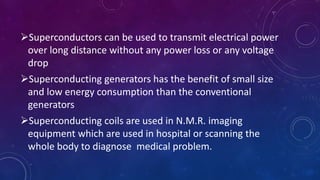Superconductivity of materials
- 2. MAIN CONTENT Superconductivity General properties of superconductors Types of superconductors High temperature superconductors Application : Magnets , Josephson effect , SQUID, Maglev, other.
- 3. INTRODUCTION SUPECONDUCTIVITY :- It is a phenomenon in which certain metals , alloys and ceramics conduct electricity without resistance when it is cooled below a certain temperature called the critical temperature. Superconductivity was discovered by a Dutch physicist , Heike Kammerlingh Onnes in 1911 and it is still an exciting field o discovery and technological application. This new state was discovered in mercury when cooled below 4.2 K.
- 4. SUPERCONDUCTORS Superconductor :- A superconductor is a material which loses all its resistance to the flow o electric current when it is cooled below a certain temperature or transition temperature. Examples :- 1. mercury 2. zinc 3. vanadium 4. tin , etc..
- 5. GENERAL PROPERTIES OF SUPERCONDUCTORS Critical temperature :- The temperature at which a material’s electricity resistivity drops to absolute zero is called the critical temperature or transition temperature Tc. Magnetic field effect :-This minimum magnetic field required to destroy the superconducting state is called critical magnetic field Hc. Critical current :- The maximum amount o current that can flow in a superconductor is called critical current Ic.
- 6. Critical current density :- The critical current density can be defined as the maximum current that can be permitted in a superconducting material without destroying its superconductivity state. Persistent current :- This steady flow of current in a superconducting ring without any potential deriving it is called the persistent current. Meissner effect :- The complete expulsion of all the magnetic field by a superconducting material is called the “Meissner effect”.
- 7. RELATIONSHIP BETWEEN CRITICAL QUANTITIES
- 8. TYPES OF SUPERCONDUCTOR Based on the behavior of superconducting material in an applied magnetic field , the superconductors are classified into :- 1. Type 1 2. Type 2
- 9. TYPE 1 SUPERCONDUCTORS Type 1 superconductors exhibit complete Meissner effect that is they are completely diamagnetic. The value of Hc of type 1 superconducting materials are always too low. The magnetization curve shows that the transition o Hc is reversible. Type 1 superconductors are also called soft conductors.
- 10. TYPE 1 SUPERCONDUCTOR GRAPHICAL REPRESENTATION
- 11. TYPE 2 SUPERCONDUCTOR Type 2 superconductors behave differently in an increasing field. For an applied field below Hc1 , the material is perfectly diamagnetic and hence the field is completely excluded. Hc1 is called the critical magnetic field and the Hc2 is called the upper magnetic critical field. Type 2 superconductors are called hard superconductors.
- 12. TYPE 2 SUPERCONDUCTORS GRAPHICAL REPRESENTATION
- 13. COMPARISON BETWEEN TYPE 1 AND TYPE 2 SUPERCONDUCTORS
- 14. APPLICATION OF SUPERCONDUCTORS Maglev (Magnetic levitation) :- Magnetic levitation or maglev is the process by which an object is suspended above another object with no other support but magnetic field. The phenomena of magnetic levitation is based on Meissner effect.
- 15. JOSEPHSONS EFFECT Josephson effect :- Two superconductors separated by a very thin strip of an insulator forms a Josephson's junction. As a consequence o the tunneling o electrons across the insulators , there is a net current across the junction. This is called D.C. Josephson effect. If a potential difference V is a applied between the two side o the junction there will be a tunneling current with angular frequency. This is called A.C. Josephson's effect.
- 16. Superconductors can be used to transmit electrical power over long distance without any power loss or any voltage drop Superconducting generators has the benefit of small size and low energy consumption than the conventional generators Superconducting coils are used in N.M.R. imaging equipment which are used in hospital or scanning the whole body to diagnose medical problem.
- 17. Very strong magnetic fields can be generated with coils made o high Tc superconducting materials. Very fast and accurate computer can be constructed using superconducting and the power consumption is also very low. Ore separation can be done efficiently using superconducting magnets


















